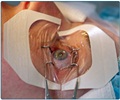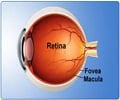Human embryonic stem cell therapy has greatly improved vision in preliminary human test and the trail has been approved by the US Food and Drug Administration.

The scientists said that the results must be considered preliminary because the number of people cured was comparatively small and they have only been followed for only less than two years.
The patients with these two conditions were injected with either 50,000, 100,000, and 150,000 stem cells for each eye disorder and the patients were followed up for a median of up to 22 months by use of serial systemic, ophthalmic, and imaging examinations.
The authors found that the injection was safe with no adverse effects. Best-corrected visual acuity, monitored as part of the safety protocol, improved in ten eyes, improved or remained the same in seven eyes, and decreased by more than ten letters in one eye, whereas the untreated fellow eyes did not show similar improvements in visual acuity.
According to the scientists, 10 participants could see significantly better, seven participants saw better without losing any additional vision.
The results of this study provide the first evidence of the medium-term to long-term safety, graft survival, and possible biological activity of stem cells in individuals with such disease. The researchers turned the human embryonic stem cells that can become any type of cell in the body, into retinal pigment epithelial cells.
"The results are really promising. I’m astonished that the therapy is working in the way that it is - or seems to be working. I’m very excited about it. These are patients that didn’t see better for 30 years and all of a sudden they’re seeing better," said Steven Schwartz, an eye specialist at the University of California, Los Angeles (UCLA) who led the study.
Ref- Steven D Schwartz, Carl D Regillo, Byron L Lam, Dean Eliott, Philip J Rosenfeld, Ninel Z Gregori, Jean-Pierre Hubschman, Janet L Davis, Gad Heilwell, Marc Spirn, Joseph Maguire, Roger Gay, Jane Bateman, Rosaleen M Ostrick, Debra Morris, Matthew Vincent, Eddy Anglade, Lucian V Del Priore, Robert Lanza. Human embryonic stem cell-derived retinal pigment epithelium in patients with age-related macular degeneration and Stargardt’s macular dystrophy: follow-up of two open-label phase 1/2 studies. The Lancet, October 2014 DOI: 10.1016/S0140-6736(14)61376-3
Source-Medindia














